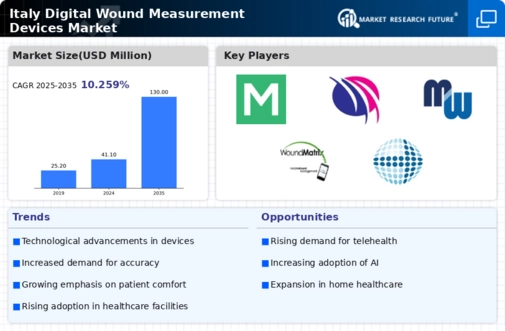Integration of Telehealth Services
The integration of telehealth services into the healthcare system in Italy is emerging as a key driver for the digital wound-measurement-devices market. Telehealth allows for remote monitoring and consultation, which is particularly beneficial for patients with chronic wounds who may have difficulty accessing healthcare facilities. The digital wound-measurement devices facilitate this remote care by providing accurate data that can be shared with healthcare providers in real-time. As telehealth adoption continues to grow, particularly in rural areas, the demand for digital wound-measurement devices is likely to increase. This trend not only enhances patient convenience but also supports healthcare providers in delivering timely and effective wound care, thereby contributing to the overall growth of the market.
Focus on Cost-Effectiveness in Healthcare
The emphasis on cost-effectiveness in healthcare is driving the digital wound-measurement-devices market in Italy. Healthcare providers are increasingly seeking solutions that not only improve patient outcomes but also reduce overall treatment costs. Digital wound-measurement devices offer precise measurements that can lead to more efficient treatment plans, ultimately saving resources and time. In a healthcare environment where budgets are often constrained, the ability to demonstrate cost savings through the use of these devices is crucial. As hospitals and clinics strive to optimize their operations, the adoption of digital wound-measurement devices is likely to rise, reflecting a broader trend towards value-based care in the Italian healthcare system.
Rising Incidence of Wound-Related Conditions
The digital wound-measurement-devices market in Italy is experiencing growth due to the increasing incidence of wound-related conditions, such as diabetic ulcers and pressure sores. According to recent health statistics, approximately 3 million individuals in Italy suffer from chronic wounds, which necessitates advanced monitoring and management solutions. This rising prevalence drives healthcare providers to adopt digital wound-measurement devices, as they offer precise measurements and improved patient outcomes. The integration of these devices into clinical practice is likely to enhance the efficiency of wound care, thereby contributing to the overall growth of the market. Furthermore, the aging population in Italy, which is projected to reach 23% by 2030, further exacerbates the demand for effective wound management solutions, positioning the digital wound-measurement-devices market as a critical component of modern healthcare.
Increased Investment in Healthcare Technology
Investment in healthcare technology is a significant driver for the digital wound-measurement-devices market in Italy. The Italian government has allocated substantial funding towards the modernization of healthcare infrastructure, with an emphasis on digital health solutions. In 2025, the healthcare technology sector is expected to grow by 15%, reflecting a strong commitment to enhancing patient care through innovative solutions. This financial support encourages the development and adoption of digital wound-measurement devices, which are essential for accurate wound assessment and management. As hospitals and clinics increasingly integrate these technologies, the market is likely to expand, driven by the need for improved clinical outcomes and cost-effective solutions. The focus on technology-driven healthcare is expected to continue, further solidifying the role of digital wound-measurement devices in the Italian healthcare landscape.
Growing Awareness of Wound Care Best Practices
There is a growing awareness of wound care best practices among healthcare professionals in Italy, which is positively impacting the digital wound-measurement-devices market. Educational initiatives and training programs have been implemented to enhance the knowledge and skills of healthcare providers in wound management. This increased awareness leads to a higher adoption rate of advanced technologies, including digital wound-measurement devices, which facilitate accurate assessments and timely interventions. As healthcare professionals become more knowledgeable about the benefits of these devices, the demand for them is likely to rise. Furthermore, the emphasis on evidence-based practices in wound care is expected to drive the market, as clinicians seek reliable tools to improve patient outcomes and reduce healthcare costs associated with chronic wounds.
















Leave a Comment